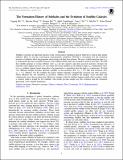Notice
This is not the latest version of this item. The latest version can be found at:https://dspace.mit.edu/handle/1721.1/136018.2
The Formation History of Subhalos and the Evolution of Satellite Galaxies
Author(s)
Shi, Jingjing; Wang, Huiyuan; Mo, Houjun; Vogelsberger, Mark; Ho, Luis C; Du, Min; Nelson, Dylan; Pillepich, Annalisa; Hernquist, Lars; ... Show more Show less
DownloadPublished version (3.623Mb)
Publisher Policy
Publisher Policy
Article is made available in accordance with the publisher's policy and may be subject to US copyright law. Please refer to the publisher's site for terms of use.
Terms of use
Metadata
Show full item recordAbstract
© 2020. The American Astronomical Society. All rights reserved Satellites constitute an important fraction of the overall galaxy population and are believed to form in dark matter subhalos. Here we use the cosmological hydrodynamic simulation TNG100 to investigate how the formation histories of subhalos affect the properties and evolution of their host galaxies. We use a scaled formation time (anf) to characterize the mass assembly histories of the subhalos before they are accreted by massive host halos. We find that satellite galaxies in young subhalos ((lownf) are less massive and more gas-rich and have stronger star formation and a higher fraction of ex situ stellar mass than satellites in old subhalos (high anf). Furthermore, these low-Anf satellites require longer timescales to be quenched as a population than the high-anfcounterparts. We find very different merger histories between satellites in fast-Accretion (FA, anf < 1.3) and slow-Accretion (SA, anf> 1.3) subhalos. For FA satellites the galaxy merger frequency dramatically increases just after accretion, which enhances the star formation at accretion, whereas for SA satellites the mergers occur smoothly and continuously across the accretion time. Moreover, mergers with FA satellites happen mainly after accretion, while a contrary trend is found for SA satellites. Our results provide insight into the evolution and star formation quenching of the satellite population.
Date issued
2020Journal
Astrophysical Journal
Publisher
American Astronomical Society